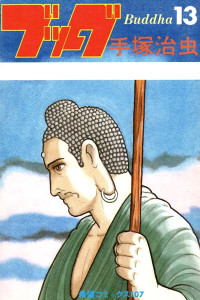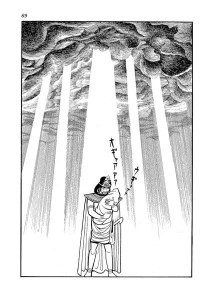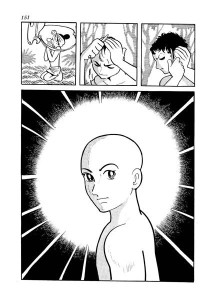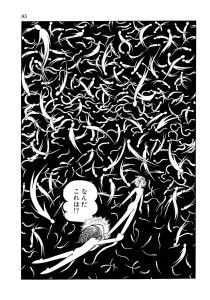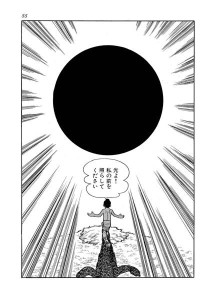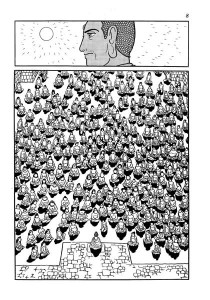Buddha (Manga)
Also known as ブッダ (Buda)
| English Title: | Buddha |
| In English? | Yes |
| Japanese Title: | ブッダ Buda |
| Type: | Ongoing Serial |
| Original run: | 1972/09 – 1983/12 |
| Published in: | Comic Tom 希望の友 |
| Published by: | Ushio Shuppan Co. |
| Volumes: | 14 MT-287 | MT-288 | MT-289 MT-290 | MT-291 | MT-292 MT-293 | MT-294 | MT-295 MT-296 | MT-297 | MT-298 MT-299 | MT-300 |
Considered one of Tezuka’s last major works, Buddha was originally serialized from September 1972 to December 1983. Published by Ushio Shuppan Co., in a publication that began as Friends of Hope, and which was subsequently changed to Shonen World and then, ultimately, to Comic Tom over the course of Buddha‘s 1972 to 1983 run, in an attempt to update the overall image of the magazine.
What it’s about
Although Buddha (1972-83) ultimately tells the epic story of Siddhartha Gautama, the man destined to become the Buddha, the story actually begins with Naradatta, a monk from the upper Brahmin caste looking for someone who will become an enlightened Buddha. Along the way, his story becomes entangled with Tatta, a child-thief from the lowest Pariah caste who is able to possess the bodies of animals, and Chapra, a young boy from the lowly Shudra slave caste who escapes his fate by saving the life of a well-known Kosalan general and being adopted as his son.
It is into this world of injustice, where society is ruled by a rigid and unforgiving caste system, that a very special little baby is born – Siddhartha Gautama. Growing up in Kapilavastu, in the foothills of the Himalayan Mountains, the first son of King Suddhodana, the leader of the Shakya people, wants for nothing. Yet, despite a veritable legion of tutors, servants and entertainers seeing to his every need, Siddhartha is a sickly child who sleeps often and is generally quite apathetic about his life of privilege. However, when he crosses paths with Tatta, all that begins to change.
The pariah boy who can posses animals talks Siddhartha into seeing the world beyond the palace walls, and takes him on a literally life-changing adventure. Already unhappy with the perceived injustice of the caste system, Siddhartha is soon forced to confront the human realities of age, disease, and death. The experience sees him reject his arranged marriage to a young princess named Yashodhara, and sets him on the path to spirituality. So, at the age of 29, Siddhartha decides to become a monk, cuts his hair and sets off into the wild – leaving his wife and young child behind.
Along the way, Siddhartha teams up with Dhepa, a monk who has burned out his own eye, and Assaji, a well-meaning but hapless child. At first Siddhartha attempts to follow Dhepa’s generally-accepted teachings – that holiness can only be achieved through dangerous torturous personal ordeals. As such, he subjects himself to several self-damaging “trials” in the sacred Forest of Uruvela, many of which very nearly cost him his life. As luck would have it though, he’s continually rescued by passersby and these acts of kindness influence him more than the rigid teachings of his fellow monks.
And so, while meditating under a Pippala tree, Siddhartha finally gains the enlightenment he has been seeking. Renamed as the Buddha, he begins to teach others about this new path to enlightenment.
What you should know
Buddha (1972-83) is often compared to another of Tezuka’s sweeping epics, Phoenix (1967-88), and while both explore many of Tezuka’s favourite themes such as the cycles of life and death, they also share another link. In 1972, with the demise of Mushi Productions’ flagship anthology magazine, COM, Phoenix (1967-88) was left without a home. Having already published a few of his one-shot stories, Ushio Shuppan Co. suggested to Tezuka that he continue the publication of Phoenix (1967-88) in their magazine, Friends of Hope. Unfortunately, since Friends of Hope was primarily a boys’ magazine targeting a much younger audience than COM, Tezuka decided against it, feeling he’d have to lower the level of the story a bit if he was to make the run successful. He also felt that Phoenix (1967-88), being a rather experimental work geared towards the manga intelligentsia, would not fit in with the rest of the serials in the magazine, and any attempt to shoe-horn it in would result in a complete change of the already-established tone and style of the series.
As such, he asked the editor-in-chief if he could write another historical series instead – and pitched a biography of the historical figure of Shakya (Siddhartha). Despite some initial concerns about publishing an overtly religious manga, the editor had faith in Tezuka’s unique brand of storytelling and agreed to the project. However, in order to lessen any perceived religious overtones, instead of naming it “The Biography of Shakya”, the series was given the English-derived title of “Buddha”, written in katakana as ブッダ (Budda), for its strong yet simple and to-the-point feel.
Although these days it is not uncommon for the word “Buddha” to be transcribed in katakana, this was not usually the case before Tezuka’s Buddha (1972-83) series began. An interesting cultural coincidence, perhaps?
Of course, never one to let facts (or the absence of them) get in the way of telling a good story, Tezuka decided create a semi-fictionalized biography of the Buddha – one that didn’t simply focus on Siddhartha’s spiritual journey towards enlightenment. Instead, Tezuka crafted an tale that relies heavily on action to move the plot along (not something normally associated with long stretches of self-reflective meditation), and one that relies on a large cast of characters, some only interacting indirectly with the main protagonist.
Although this opened the series up to heavy criticism from those who expected it to be a proper interpretation of the biography of the Buddha, Tezuka maintained that while anyone could simply transpose a biography into manga form, that would not necessarily make it very interesting or entertaining. He also felt emboldened in his artistic license by the fact that there are some obscurities and varying theories in regards to the Buddha’s life story.
As he mentioned in the Afterword to the Osamu Tezuka Complete Manga Works edition (MT-300), “If I removed all of the fictional elements from Buddha, there would be so little left that it could not be called a story” (1984, p. 279). These elements are not simply those related to the characters or plot. In some cases Tezuka even changed many Buddhist thoughts and doctrines, in many ways the most important parts, to fit his own interpretations.
Given the fact that Tezuka is best described as a Humanist, rather than a Buddhist, it should come as no surprise that many of the views presented lean in that direction. While the teachings may not adhere strictly to Buddhist doctrine, Tezuka’s central message that “all life is sacred” comes shinning through. Through this, Tezuka is able to explore the injustice wrought by the caste system and the inhumane treatment of people in a land plagued by constant drought, famine and warfare.
In other words, the series is a complete work of fiction, a manga story “based on real events” and crafted using the life story of the Buddha as an inspiration.
Where you can get it
Luckily, for English-speaking fans, Buddha (1972-83) was published in 2003 by Vertical Inc. Originally released as a set of eight hardcover volumes, this edition featured award-winning cover designs by Chip Kidd, which, when complete, shows three images of the Buddha along the spine – something that looks fabulous when lined up on a bookshelf. After the original hardcover editions were out of print, Vertical Inc. republished Buddha in a very nice softcover, eight volume, trade paperback edition.

